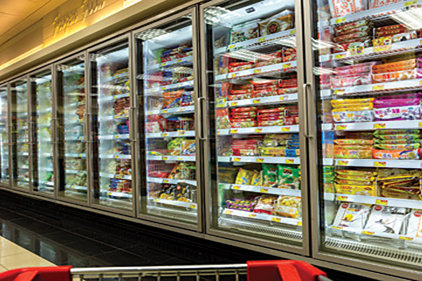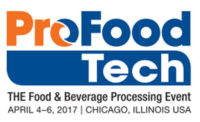TECH FLASH
Top 150 Frozen Food Processors Report
Industry overcomes consumers’ negative perception about the health and wellness of frozen foods.

Click here to see the latest Top 150 Frozen Food Processors report!
In May 2014, the American Frozen Food Institute (AFFI), McLean, Va., launched a national effort to encourage consumers to take a fresh look at frozen foods. The “Frozen. How Fresh Stays Fresh.” initiative is compiled of leading American frozen food makers who have come together to inform and remind consumers that freezing simply pauses just-picked, just-baked and just-crafted foods, locking in their freshness, flavor and nutrients.
“Keeping food fresh is what freezing is all about,” says Kraig Naasz, president and CEO of AFFI. “Freezing is simply nature’s pause button that keeps fresh foods at their peak of freshness.”
Fast forward to today, and the frozen foods industry continues to overcome consumers’ negative perception about the health and wellness of frozen foods.
In honor of March being National Frozen Foods Month, this is Refrigerated & Frozen Foods’ annual Top 150 Frozen Foods Processors report, which breaks down the Top 25 frozen food processors in each of the six sectors. Processors are ranked by annual net sales and listings.
While 50.8% of the processors updated their profile(s) via our online portal (22 companies appear in more than one category), other processors declined to provide annual sales or refused to update company information. Those frozen foods sales figures and estimates, which are marked with an asterisk (*), are based on company reports, news releases, market analysts’ reports, industry media and more. This report represents Refrigerated & Frozen Foods’ best efforts to reflect pertinent sales from all channels.
A special thank you goes to Refrigerated & Frozen Foods’ sister publications—National Provisioner and Dairy Foods—for providing projected sales figures in the meat/poultry and dairy foods sections, respectively. And, of course thank you to all of the respondents for taking the time to update their company information. Going straight to the source is a million times more credible than pulling information from the internet, so for that, we appreciate your cooperation.
CLICK HERE TO VIEW THE FULL REPORT!
Meals & Entrees
Meat, Poultry & Seafood
Dairy
Snacks, Appetizers & Side Dishes
Bakery
Fruits and Vegetables
Here's how the report works: hover over each company name to find a compilation of articles pertaining to that company.
Meals & Entrées: Acquisitions Extend Category Growth
First, Ajinomoto North America acquired Windsor Foods, then High Liner Foods acquired Atlantic Trading Co. and in January, AdvancePierre Foods acquired Landshire, all within six months of each other. These are just some of the major acquisitions unfolding within the frozen meals and entrées category.
Changes from last year’s report
Significant events in 2014-15
Significant events still to come in 2015
Meat, Poultry & Seafood: Overcoming Food Fraud One Acquisition at a Time
Between protecting the food chain from food fraud and controlling Salmonella outbreaks, the frozen meat, poultry and seafood category has been tasked with some super-sized food safety initiatives.
Thankfully, these Top 25 players overcome food safety dilemmas with company acquisitions, new product developments and more.
Find out who acquired whom, what companies expanded and what’s in store for this forward-thinking category for the remainder of the year.
Changes from last year’s report
Significant events in 2014-15
Significant events still to come in 2015
Dairy: New Product Development Shapes the Future of the Frozen Dairy Market
In a market where companies are growing, building and acquiring, the frozen dairy market for the most part, has remained stagnant. However, a noteworthy list of indulgent new ice cream flavors and a variety of frozen Greek yogurts keep the Top 25 frozen dairy processors in the game.
Changes from last year’s report
Significant events in 2014-15
Significant events still to come in 2015
Snacks, Appetizers & Side Dishes: Consolidation Leads to Greater Growth
For the frozen snacks, appetizers and side dishes sector, it’s all about consolidation, consolidation, consolidation. Whether it’s combining two manufacturing facilities into one or merging with another company, these players remain in the Top 25 of their market thanks to some strategic moves that make them bigger and better than before.
Significant events in 2014-15
Significant events still to come in 2015
Bakery: Frozen Bakery Aisle Intensifies with Change
From company acquisitions to plant expansions, the frozen bakery market is experiencing a great deal of change.
Find out how the Top 25 frozen bakers experienced growth through expansion, consolidation and mergers and acquisitions.
Changes from last year’s report
Significant events in 2014-15
Significant events still to come in 2015
Fruits & Vegetables: Frozen is Key to a Balanced Diet
While Americans struggle to add more fruits and vegetables to their diets, a recent study reveals one simple solution—frozen. That’s why many of today’s frozen fruit and vegetable processors are taking a front seat to their fresh counterparts.
Changes from last year’s report
Significant events in 2014
INDUSTRY NEWS & TRENDS
STUDY REINFORCES NUTRITIONAL BENEFITS OF FROZEN FOODS
While Americans struggle to add more fruits and vegetables to their diets, a recent study reveals one simple solution - frozen. The Frozen Food Foundation, a not-for-profit organization, partnered with the University of California-Davis (UC Davis), Davis, Calif., to evaluate the nutrient content of eight commonly-purchased frozen and fresh fruits and vegetables—blueberries, strawberries, carrots, corn, broccoli, green beans, green peas and spinach. The study used methodologies designed to eliminate discrepancies in the harvesting, handling and storage of fruits and vegetables. Findings revealed that the nutritional value of frozen fruits and vegetables are generally equal to—and in some cases better than—their fresh counterparts. While Americans struggle to add more fruits and vegetables to their diets, a recent study reveals one simple solution—frozen.
The study, conducted by lead researcher Dr. Diane Barrett of UC Davis, used methodologies designed to eliminate discrepancies in the harvesting, handling and storage of fruits and vegetables. Like produce found in farmers’ markets, the fruits and vegetables used in the study were locally grown, harvested and stored by the UC Davis research team. Each fruit and vegetable was analyzed under the following conditions—frozen (analyzed within 24 hours of harvest and after 10 and 90 days of storage in a freezer) and fresh-stored (analyzed within 24 hours of harvest and after three and 10 days of storage in a refrigerator).
“The study was designed to mimic the quality of produce found at farmers’ markets or grown in consumers’ backyards,” says Barrett. “The study revealed that in most cases, frozen produce is nutritionally equivalent and often superior to its fresh-stored counterpart. In particular, the vitamin C content of frozen corn, green beans and blueberries was significantly higher than their fresh-stored counterparts.”
The nutritional value of water-soluble vitamins—namely the amount of riboflavin (vitamin B2) and vitamin C (ascorbic acid)—was generally the same or greater in frozen vs. fresh produce.
The study also found that freezing has a positive effect on the vitamin E content of the fruits and vegetables as compared with fresh.
Additionally, the nutrient value of five minerals (calcium, magnesium, zinc, copper and iron), fiber and total phenolics (health-promoting plant compounds) were for the most part well-conserved in frozen fruits and vegetables as compared to fresh.
“Freezing is simply nature’s pause button,” says Kraig Naasz, president of the Frozen Food Foundation and president and CEO of the American Frozen Food Institute (AFFI), an affiliation of the foundation. “This research adds to a growing body of evidence that supports the important role frozen fruits and vegetables can play to help Americas meet daily intake requirements.”
Likewise, new analysis from the 2003-2010 What We Eat In America (WWEIA) National Health and Nutrition Examination Survey (NHANES), a program of the Centers for Disease Control and Prevention (CDC), indicates that consumers of frozen meals (compared to consumers of quick-service restaurant meals) consume fewer calories and reached a better Healthy Eating Index score.
“The analysis shows consumers of frozen meals come a little closer to meeting Dietary Guidelines for Americans than consumers of quick-service restaurant meals, and they do it with 253 fewer calories a day,” says Dr. Victor Fulgoni, co-author of the analysis and vice president of Nutrition Impact, LLC, Battle Creek, Mich.
That’s why in May 2014, AFFI launched a national effort to encourage consumers to take a fresh look at frozen foods.
The “Frozen. How Fresh Stays Fresh.” initiative is compiled of leading American frozen food makers, most included in this year’s Top 150 Frozen Foods Processors report, who came together to educate consumers that freezing simply pauses just-picked, just-baked and just-crafted foods, locking in their freshness, flavor and nutrients.
The campaign is a 3-year, $30 million-per-year effort to engage consumers where they live, work and shop through national television, digital and print advertising, online engagement and in-store and out-of-store promotion.
STUDY SHOWS CONSUMERS WARMING UP TO FROZEN FOODS
For the past couple of years, consumers’ negative perception of frozen foods has placed some unnecessary pressure on processors to better educate their shoppers. However, a recent study shows that the hard work is paying off. That’s because frozen foods still appeal to the majority of American consumers, according to “Frozen Foods in the U.S.: Hot Meals, Sides and Snacks,” a report conducted by market research publisher Packaged Facts.
“Frozen foods of all kinds have been challenged in recent years as a result of the convergence of several trends, especially but not exclusively, a growing demand for fresh products, or at least, fresher products in refrigerated rather than frozen form. Nevertheless, frozen food products still have much to offer,” says David Sprinkle, research director. “For instance, frozen products identified as natural or organic are having a more positive experience than frozen foods in general. These organic and natural frozen foods appeal to the consumer who is both cost conscious and health conscious.”or the past couple of years, consumers’ negative perception of frozen foods has placed some unnecessary pressure on processors to better educate their shoppers.
However, a recent study shows that the hard work is paying off. That’s because frozen foods still appeal to the majority of American consumers, according to “Frozen Foods in the U.S.: Hot Meals, Sides and Snacks,” a report conducted by market research publisher Packaged Facts.
Packaged Facts estimates that sales of the collective frozen food categories, such as dinners/entrées, pizzas, side dishes and snacks/appetizers will edge up to $23 billion in 2019. And, increased sales will be based on the ability of major marketers to adjust to the changing consumer environment that calls for more variety, healthier foods and better pricing.
Looking for a reprint of this article?
From high-res PDFs to custom plaques, order your copy today!






